Case Studies
Case Study 1
All-in-one Design
122 injection nozzles and further parts as one integrated component
“Mission Critical” perfectly describes the Class 1 components used in the aerospace industry. Missions costing hundreds of millions depend on these components. Accordingly, engineers are constantly seeking to develop components of the highest quality, functionality, and robustness while simplifying the manufacturing chain and reducing the number of individual elements. Thanks to EOS additive manufacturing technology, ArianeGroup has succeeded in taking this to a whole new level: Instead of 248 elements, the injector head of a rocket engine of a future upper stage propulsion module now counts just one component. The injector head has been simplified and reduced to what is literally an all-in-one (AiO) design.
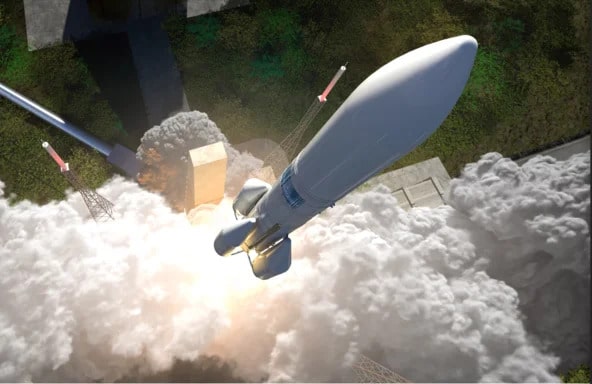
The additively manufactured injector head as all-in-one Design (AiO) of a rocket engine with 122 injection elements is made from EOS NickelAlloy IN718.
On Ariane program, we are combining our innovative strength with the expertise of EOS. Together, we work on the additive manufacturing of an injector head for a rocket engine. The results are impressive: Significant reduction in production time and 50 % lower costs.
Dr.-Ing. Steffen Beyer | Head of Production Technology, Materials & Processes | ArianeGroup
Production of an injection head for rocket engines with as few components as possible and lower unit costs
The European Space Agency (ESA) wishes to assume a strong and independent position in space transportation using efficient launch vehicle technology. In order to achieve this, ArianeGroup, a joint venture by the European aerospace company Airbus Group and the French group Safran, was commissioned to construct the next generation. Ariane is a series of European launch vehicles designed to enable heavy payloads, such as communications satellites, to be put into orbit around the earth.
In a propulsion module, tremendous forces develop under extreme conditions. This demands maximum levels of reliability and precision in a small space. The injection head is one of the core elements of the propulsion module, feeding the fuel mixture into the combustion chamber.
Its traditional design consists of 248 components, produced and assembled in various manufacturing steps. The different processing steps, such as casting, brazing, welding, and drilling, can result in weak points that can constitute a risk under extreme loads. Moreover, it is a timeconsuming and complex process. In the field of injector elements, conventional production requires over 8,000 cross holes to be drilled in copper sleeves that are then precisely screwed to the 122 injector elements in order to mix the hydrogen that streams through them with oxygen.
A glance at these figures clearly shows that, one functionally integrated component combining all the elements must be the obvious but ambitious goal. This could also release significant economic potential and cut the number of processing steps as well as production time, especially for a Class 1 component.
An additively manufactured product that comprises a single element instead of 248 individual parts thanks to functional integration
The solution for these challenges is provided by additive manufacturing. “The production of the injector head in one piece is possible using EOS technology,” says Dr.-Ing. Steffen Beyer, Head of Production Technology – Materials & Processes at ArianeGroup, explaining why industrial 3D printing was chosen. “Only additive manufacturing can combine integrated functionality, lightweight construction, a simpler design, and shorter lead times in a single component.” The project team again chose a heat- and corrosion-resistant nickel-based alloy (IN718) as the material. This material provides excellent tensile, endurance, creep and fracture strength at high temperatures and and will also be used with the new production technology.
“After successfully developing the component, we turned our attention to cost efficiency,” reports Dr. Fabian Riss, Production Technology – Materials & Processes. The key requirement from ArianeGroup was to reduce lead times and unit costs. Manufacturing was initially performed by an incremental process with the EOS M 290. After successful pilot tests, production was scaled up to the larger EOS M 400-4 system. 4-laser technology allowed the propulsion module component to be manufactured up to four times as fast. “Scaling up the construction process to the high-productivity EOS M 400-4 system was an important step for us in order to advance the industrialization and competitiveness of the Ariane project. The collaboration unfolded very efficiently thanks to the experience and industry expertise of EOS staff. The results speak for themselves and are proof of great team performance,” adds Dr. Steffen Beyer.
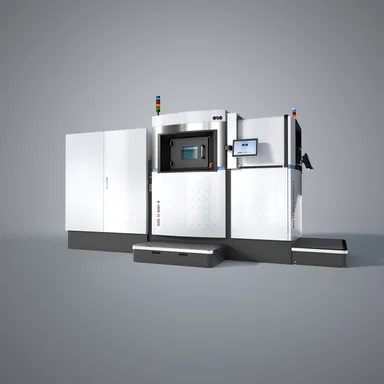
The results of the new injector head produced using additive manufacturing are extremely impressive: Instead of 248 parts, it consists of just one – with the same functionality, and cutting the required time down to a minimum.
The powder bed-based, industrial 3D printing technology from EOS meant that it was possible, for example, to print the 122 injection nozzles, the base and front plates, and the distribution dome with the corresponding feed pipes for the hydrogen and oxygen fuels as one integrated component. Compared with single-laser systems, the significantly higher productivity of the EOS M 400-4 multi-laser system was able to cut construction time by a factor of 3 and costs by 50 % in the example of the AiO injector head.
The project team was able to clock up a whole series of additional successes. The simplified design and the improved material properties compared with the quality of cast parts allowed the additive technology to reduce the wall thickness considerably – without losing any strength.
Cutting weight significantly also meants a further reduction in construction time and, of course, costs.
Last but not least, additive manufacturing processes allow innovation cycles to be sped up significantly. Structural improvements, design modifications, and the manufacture of test components in the development phase can be put directly into production based on CAD data without requiring engineers to spend time preparing tools, as is the case when casting parts. Industrial 3D printing thus achieves a quantum leap in terms of lead time. Whereas each iteration generally used to require around half a year, one iteration now only takes a few days. On top of this, the entire manufacturing chain now unfolds in-house on ArianeGroup’s premises. In a nutshell: Mission accomplished!


Case Study 2
New Perspectives Created by Eyewear Specialists Hoet – Made Possible With the Support of Raytech and EOS
“The eye is the point at which the soul and body merge.” It is not clear whether the designers from Hoet oriented themselves on this quote by dramatist and lyricist Christian Friedrich Hebbel. But looking at the classic and inimitable design of the new collection, one could easily think so. This eye-catching range was made possible by Additive Manufacturing technology. EOS partner Raytech from Belgium was responsible for the technical realization of the design.
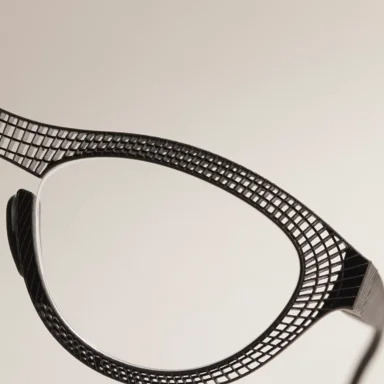
We had three reasons for choosing on Additive Manufacturing for our new eyewear frames: We were able to create things in a way that would not have been possible with standard technologies. We could manufacture various sizes without incurring additional costs. And it is a green technology that, thanks to its flexibility, clearly reduces consumption of both energy and materials.
Patrick Hoet | Managing Director | Hoet
Production of an eyewear series with specific design characteristics that meet the precise demands of the client
Consumer product manufacturers are just as beholden to innovation as companies in other industries– the competition for the customer is hard, and woe be to those who lack ideas or the right formula. Besides pure functionality, what counts, particularly in the consumer environment, are aesthetic arguments with sales appeal. The customer offers money in his hand for something that is pleasing to his eye.
Hoet, a company that specializes in the development and production of eyewear, was searching for an innovative response to this challenge.
The Belgian family-run company which was founded in 1884 had set the bar particularly high with its Cabrio eyewear. This innovative design, which combines sunglasses and a cap visor to provide dual protection from solar rays, was designed by Bieke Hoet. The designer, who heads the company, invented a proprietary laminated polypropylene material for the production of the eyewear house’s frames. This approach to experimentation shows openness to the adoption of new perspectives and enabled the company to see the logic in expanding its production repertoire and choice of materials.
Not only did it have the courage to seek new paths, but it was also convinced that environmental sustainability was a key component of any new approach. From the beginning, the company also had its sights set firmly on costs. Armed with this triad of clear-cut prerequisites – the search for fresh design possibilities, acceptable costs levels and sustainable production – Hoet began searching for a new production process for its latest product line. The eyewear specialist soon turned their attention to additive manufacturing.
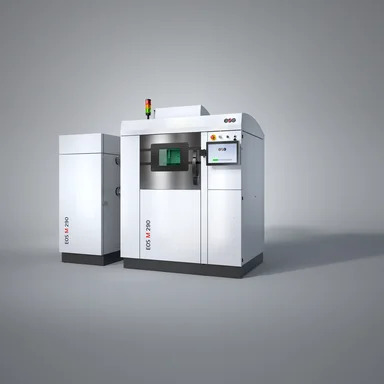
Additive manufacturing of eyeglass frames with a honeycomb structure made of titanium using the EOS M 290
Industrial 3D printing offers outstanding and unrivalled design freedom. Not only can this advantage be applied to the manufacturing of prototypes, but it also offers immense added value in series production – particularly with products whose design and aesthetics play a significant role in the customers’ purchase decision. ‘Anything goes’ could be the tag line for Additive Manufacturing. That Hoet, a design-driven company, was attracted to the technology is no surprise. With an eye on the exceptional freedom it affords in the realization ideas, Bieke Hoet set to work on creating designs for the collection.
Once the creative work had been completed, the company chose apply existing expertise to ensure its efficient production. The search for an experienced partner eventually led to Raytech, a company based close to Hoet’s premises in Bruges. Raytech had many years of experience and displayed the required level of expertise in additive manufacturing. For example, the company is a supplier to the electronic and automotive industries. The metal-based version of the technology, in which a laser builds up a component layer by layer from a powder, is of huge significance to clients in these sectors.
Together, Hoet and Raytech developed a production concept. This included the use of EOS Titanium Ti64 as the core material. Titanium is often used for eyewear frames, because it combines extreme flexibility with high strength and low weight. The metal is also one of the numerous raw materials that can be processed with EOS technology. So the design, material and process were now in place. All that was missing was the means of production. Raytech decided once again to utilize its in-house EOS system: “What convinced us about EOS was the company’s excellent service and, in particular, its quick and competent application advice. Its hands-on attitude, fast response and leading technology, combined with an excellent production system, maked for a coherent overall package,” says Paul Raymaekers, owner and managing director of Raytech.
In our opinion, EOS is the best partner that we could work with in the additive manufacturing sector. We were particularly impressed that we had immediate access to contacts with a high level of competence in the optical sector and with regard to the titanium material that we use. This basic knowledge, coupled with the quickly produced, high value test samples, convinced us that we had made the right choice of partner.
Paul Raymaekers | Owner and Managing Director | Raytech
The results achieved by the triumvirate of Hoet, Raytech, and EOS will not only look great, but they will be there for all to see. The various complex and delicate lattice structures of the frames would not have been possible with conventional technology. The realization of the inimitable classic design was only made possible with the EOS M 290. Yet despite achieving the appearance it had been looking for, Hoet still had some other demands on its list – and these too were met by additive manufacturing. Because there are no further tooling costs, one and the same machine can produce variety of sizes, quickly and easily, and with no additional costs. Together with the appropriate software and scanning equipment, it can even manufacture custom-made frames for each respective model.
This enhances the comfort of the eyewear. Bieke Hoet also stresses a further point: normally, between 30-40 % of the eyewear produced remains unsold in the drawers of the wholesaler or retailer.
Under these conditions exact production planning is very difficult. But with additive manufacturing, it is possible to manufacture on demand, eliminating the need to build up stocks.
This not only reduces storage costs but also lowers the average production costs of the products sold.
A further advantage of the technology is the short time to market, i.e. the time between the product’s design and its availability in retail outlets. Just two months after the installation of the system, the frames were ready to go on sale. And, if required, the manufacturing of additional stock only requires a few days.
“Additive manufacturing has proven its worth across many areas of application. It is in generally its functional aspects that are the central. For us, however, it was the design possibilities offered by the technology that were key to our decision,” summarizes Hoet.
“We wanted to give the market something that was genuinely new. By using additive manufacturing, we have once again followed the credo of the Cabrio range: the use of new materials and technologies adds further benefits and advanced aesthetics to the field of eyewear design.” To end with a quote from Mark Twain, one of the greats of world literature: ‘You can’t depend on your eyes when your imagination is out of focus.’ In her company, Bieke Hoet brings a clarity of vision that helps customers realize new aesthetic perspectives and 20/20 vision.

Case Study 3
Function integration reduces the number of single parts and the expenditure for assembly
Thanks to the high degree in design flexibility, the design determines the production method
Innovative manufacturing method makes grippers light-weight and long-lasting
Laser sintering was the only process that made it possible to produce the Bionic Handling Assistant and its gripping element, the DHDG adaptive gripper. Due to the complexity and integrated functionality of the components, there is no alternative way of production.This process enables us to adjust the DHDG adaptive gripper to the specific application and is thus already used by customers all over the world.
Klaus Müller-Lohmeier | Head of Advanced Prototyping Technology | Festo AG & Co. KG
Additive Manufacturing Offers New Design Solutions for a More Economic Small Batch Production
One example of successful product development and production using additive manufacturing is the DHDG adaptive gripper. It has become an inherent part of Festo‘s production range and is manufactured on a FORMIGA P 100 supplied by EOS. Its structure is adapted from a fish fin and has two flexible bands which form a triangle to converge at the top. Intermediate webs are connected to the bands via joints at regular intervals.
Another example is the Bionic Handling Assistant. The flexible assistance system, which is modelled after an elephant‘s trunk, consists of three basic elements for spatial movement, a hand axis and a gripper with adaptive fingers. With a FORMIGA P 100, a complete handling assistant can be manufactured in just four building sessions.
The EOS technology makes it possible to directly incorporate functions that the final product is supposed to have. This is advantageous, since it reduces the number of parts and the additional assembly costs.
Moreover, the DHDG adaptive gripper is very economic, because it is about 80 % lighter than conventional grippers made of metal. The reason for this is the additive manufacturing of plastics which allows the production of especially light-weight, elastic but very strong structures. Tool-less production saved 40 % of the unit costs compared to injection moulding.
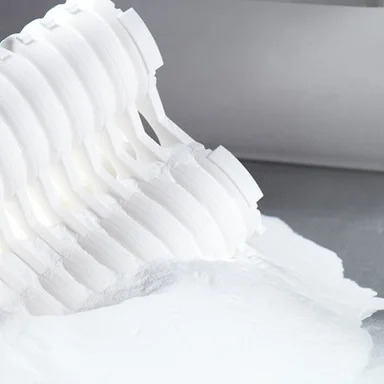
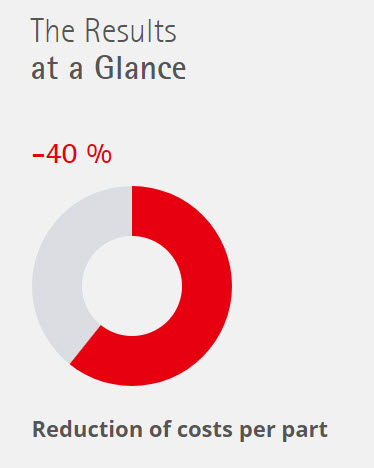
At the moment, we are also using the EOS technology more and more for projects that only call for limited annual quantities of a complex part. In such cases, the process is a real alternative for us to existing, often tool-based methods.
Klaus Müller-Lohmeier | Head of Advanced Prototyping Technology | Festo AG & Co. KG